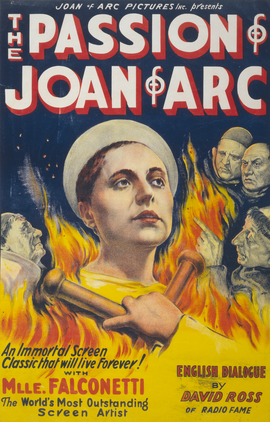The Passion of Joan of Arc (1928 film)
 U.S. theatrical release poster | ||
| Starring | Renée Jeanne Falconetti Eugène Silvain André Berley Maurice Schutz Antonin Artaud | |
| Directed by | Carl Theodor Dreyer | |
| Written by | Carl Theodor Dreyer Joseph Delteil | |
| Editing by | Marguerite Beaugé Carl Theodor Dreyer | |
| Music by | Léo Pouget Victor Alix | |
| Cinematography | Rudolph Maté | |
| Distributed by | Société Générale des Films | |
| Released | Apr 21, 1928 in Denmark Oct 25, 1928 in France | |
| Runtime | 110 minutes (20 fps) 82 minutes (24 fps) | |
| Country | France | |
| language | French (intertitles) | |
The Passion of Joan of Arc (French: La Passion de Jeanne d'Arc) is a 1928 French silent historical film based on the actual record of Joan of Arc's trial. The film was directed by Carl Theodor Dreyer and stars Renée Jeanne Falconetti as Joan. It is widely regarded as a landmark in cinema,[1] especially for its production, Dreyer's direction, and Falconetti's performance, which is often considered one of the finest in film history. The film covers the period when Joan of Arc was a captive of England,[2] depicting her trial and execution.
The film was shot on a single, massive concrete set modeled on medieval architecture to portray the Rouen prison realistically. The film is known for its cinematography and use of close-ups. Dreyer did not allow the actors to wear make-up and used lighting that made them look more grotesque. Prior to its release, the film was controversial due to French nationalists' skepticism about whether a Dane could direct a movie about one of France's most revered historical icons. Dreyer's final version of the film was cut down due to pressure from the Archbishop of Paris and government censors. For several decades, it was released and viewed in various re-edited versions that attempted to restore Dreyer's final cut. In 1981, a print of Dreyer's final cut was discovered in Dikemark Hospital, a mental institution just outside Oslo, Norway, and re-released.
Despite objections and censorship by clerical and government authorities, the film was a major critical success upon its initial release and has consistently been regarded as one of the greatest films ever made. It has received praise and references from many film directors and musicians. The film was ranked number 4 on the prestigious Brussels 12 list at the 1958 World Expo.
As a work published in 1928, the film entered the public domain in the United States in 2024.
Plot
After leading the French in numerous battles against the English during the Hundred Years' War, Joan of Arc was captured near Compiègne and eventually brought to Rouen to stand trial for heresy by French clergymen loyal to the English.
On May 30, 1431, Joan was interrogated by the French clerical court. Her judges, who sided with the Burgundian-English coalition and opposed the King of France, tried to get her to say something that would discredit her claim or undermine her belief that she was given a mission by God to drive the English out of France. However, she remained steadfast. One or two of them, believing she was indeed a saint, supported her.
The authorities then resort to deception. A priest reads a fake letter in prison to the illiterate Joan, supposedly from King Charles VII of France, telling her to trust the sender. When that also fails, Joan is taken to see the torture chamber, but the sight, though it causes her to faint, does not scare her. When she is threatened with being burned at the stake, Joan finally breaks and allows a priest to guide her hand in signing a confession. However, the judge then sentences her to life in prison. After the jailer shaves her head, she realizes she has been unfaithful to God. She demands that the judges return and she recants her confession.
As more and more people around her begin to recognize her true faith and calling, she is allowed a final communion mass. She is then dressed in sackcloth and taken to the place of execution. She helps the executioner tie her bonds. The crowds gather, and the fire is lit.
As the flames rise, the women weep and a man cries out, "vous avez brûlé une sainte" ("you have burned a saint"). The troops prepare for a riot. As the flames consume Joan, the troops and crowd clash, and people are killed. A subtitle states that the flames protect her soul as it rises to Heaven.
Notes
![]() This article has been abridged and edited using Grammarly to make it more user-friendly, and to standardize spelling and text formatting. R/
This article has been abridged and edited using Grammarly to make it more user-friendly, and to standardize spelling and text formatting. R/
External links
- Review The Passion of Joan of Arc (1928 film) at the Internet Movie Database
- The Passion of Joan of Arc at AllMovie
- Review The Passion of Joan of Arc (1928 film) at the Turner Classic Movie Database
- Passion of Joan of Arc DreyersThePassionOfJoanOfArc is available for free viewing and download at the Internet Archive|}}
- The Passion of Joan of Arc (1928 film) at Rotten Tomatoes
- Realized Mysticism in The Passion of Joan of Arc an essay by Carl Theodor Dreyer at the Criterion Collection
- Voted No. 4 on The Arts and Faith Top 100 Films (2010) https://web.archive.org/web/20100421163123/http://artsandfaith.com/t100/thepassionofjoanofarc.html Date: 21 April 2010
- More information is available at [ Wikipedia:The_Passion_of_Joan_of_Arc_(1928_film) ]
Chat rooms • What links here • Copyright info • Contact information • Category:Root